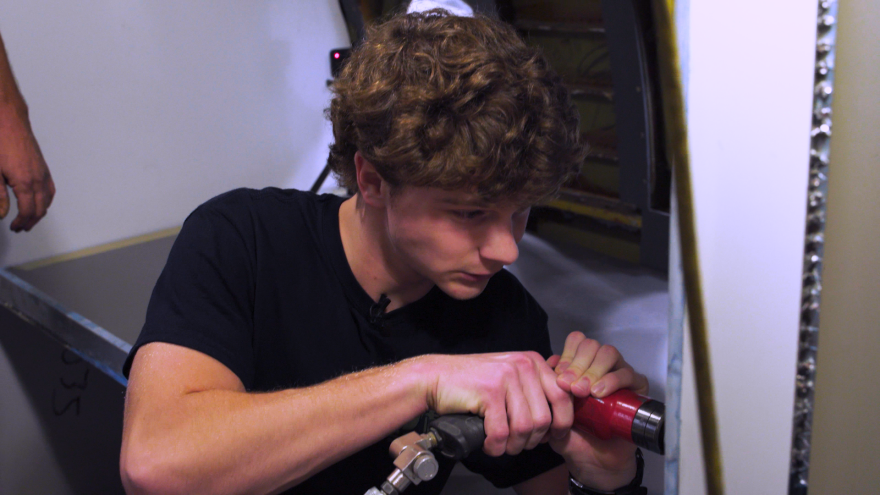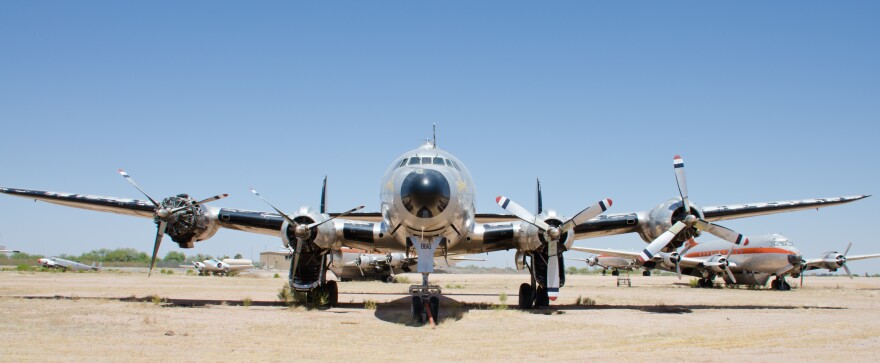Adam Brumbaugh's first day on the job at Dynamic Aviation was not what he expected. And he never imagined he'd eventually find himself working on the company's most important restoration project: a four-engine Lockheed Constellation that happens to be the very first Air Force One.
Student Adam Brumbaugh restores first Air Force One in the collection of Dynamic Aviation. (Video: Paul T. Roberts)
As one of 22 interns, Brumbaugh knew he was going to work in maintenance, but he didn't realize what that would mean until he was assigned to a massive structure known as the “Historic Hangar.”
At 17 years old, Brumbaugh found himself inside the Historic Hangar, alone and surrounded by the classic aircraft that Dynamic collected at its headquarters in Bridgewater, Virginia. Most of the airplanes were nearly 100 years old yet immaculate — except for two. One of the exceptions loomed before him: a bright yellow biplane that was somewhere between immaculate and a mess.
The biplane had flown just the day before and was covered in engine oil (a typical side effect of flying). Armed with shop rags and a bottle of alcohol, Brumbaugh was given one of aviation's most menial tasks: wiping oil off an aircraft.
To his surprise, Brumbaugh was trusted to work alone on his first day at work. “I was expecting [something] like a tour. Or someone sitting there hovering over me watching,” says Brumbaugh. “It was a cool experience but also a scary one,” recalls Brumbaugh. “I didn't want to mess anything up!”

Brumbaugh's fascination with aviation began as a child, when he’d play with toy airplanes. As he got older, he became interested in photography and would study aircraft photos. Unlike many who gravitate to aviation, Brumbaugh had no family or friends to inspire him. His interest was uniquely and organically his own.
At 16, Brumbaugh got his first taste of aviation through NextGen, a STEM program sponsored by Dynamic. According to Phil Douglas, who currently heads up the First Air Force One restoration project, the program has introduced somewhere between 3,000 and 4,000 Shenandoah Valley students to aviation and the STEM jobs the industry needs to fill.
“NextGen exposes them to what the possibilities are in the future,” Douglas says. He added that many students “don't know what their capabilities are. We just want to show them: 'You can do this. If you really want to do this, here's a pathway.'”
Following his experience with NextGen, Brumbaugh signed up for Dynamic's summer internship. He continued working at Dynamic during the school year by taking advantage of a field program offered through Shenandoah Valley Governor's School, where he is a senior. While at Dynamic Aviation, Brumbaugh worked his way from wiping up oil to assisting with Dynamic's biggest restoration project: the first Air Force One.
“I walked in and I was like 'Wow. That's a really big plane!'” says Brumbaugh. “I thought it was a WWII [aircraft] that flew overseas as a bomber. But for it to have such a larger background, it was really eye-opening.”
360° view of the first Air Force One's cockpit under restoration. Click and drag on the image to rotate view. (Photo: Paul T. Roberts)
President Dwight Eisenhower was aboard Dynamic's Constellation in May 1954. The aircraft, which served as an executive transport for high government officials, was passing over Richmond, Virginia when the crew routinely identified themselves to air traffic control using the aircraft's registration number: 8610.
But it just so happened that a nearby airliner was using 8610 for its flight number. The two flight crews and air traffic control became confused as to who was talking over the radio. This incident led to the adoption of “Air Force One” for any Air Force aircraft carrying the president. Likewise, a Marine aircraft carrying the president is known as “Marine One.” When President George W. Bush landed on an aircraft carrier, that aircraft was called "Navy One.”

When Dynamic bought the large, four-engine, propeller-driven airplane in 2015, it had languished for years in the Arizona desert. Following a desert repair effort, the Federal Aviation Administration granted permission to fly the aircraft to Bridgewater - where the real work would take place.

Brumbaugh's current job is helping to restore the Luggage Area where passengers boarded. “My most interesting job was a lot of measuring, troubleshooting, and deconstruction of the old bulkheads and floors,” says Brumbaugh, who is now 18 years old. “Because when you take off the bulkhead, you open it up to see how they made it. It was really interesting to me that you're taking apart something that's been there for so long. It hit me that I might be one of the last people that would ever touch this piece.”
With Brumbaugh's help, the large, four-engine airplane named Columbine II will become a traveling museum. Once restored, it will fly around the country to serve as a reminder of the airplane's place in history and the significance of its most important passenger: President Dwight Eisenhower.
To keep up with their progress go to: firstairforceone.org and look for the updates tab at the top of the page.


